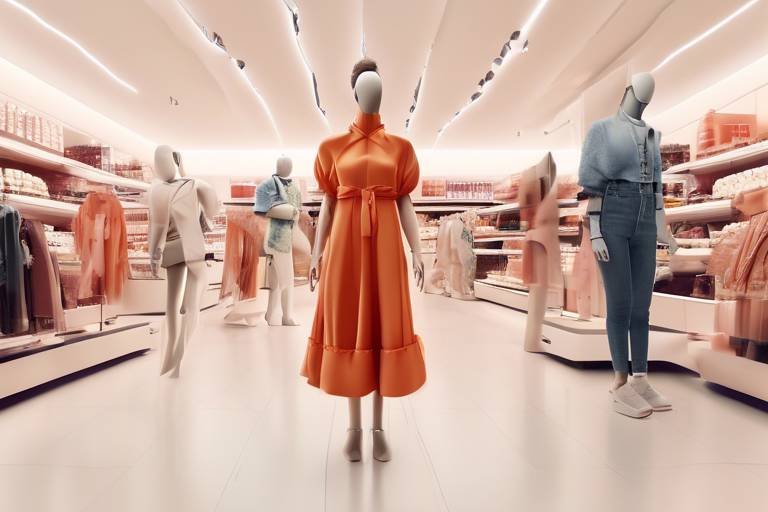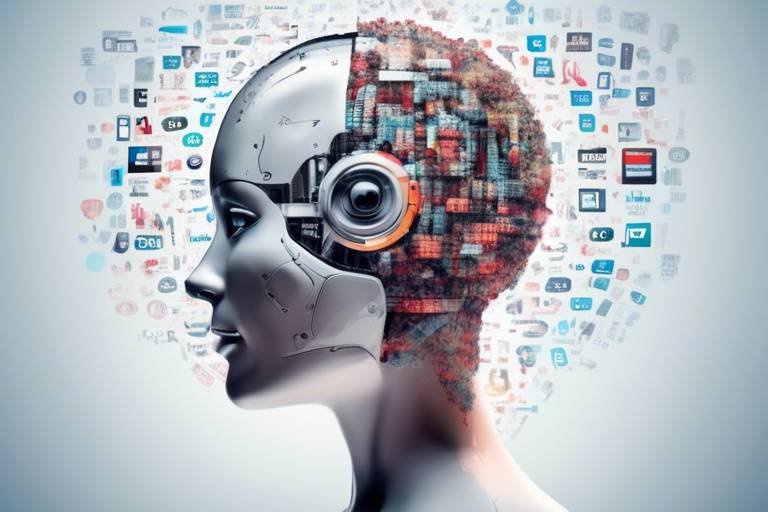AI in Retail: Reinventing Shopping Experience
In today's fast-paced world, artificial intelligence (AI) is not just a buzzword; it’s a game changer in the retail sector. Imagine walking into a store where every product seems to call your name, tailored just for you. That’s the magic of AI! It transforms the mundane shopping experience into something extraordinary, where personalization meets efficiency. Retailers are leveraging AI to create a shopping environment that feels intuitive, engaging, and tailored to individual needs. The future of shopping isn’t just about what you buy; it’s about how you feel while shopping. With AI, the experience is about understanding customers on a deeper level and enhancing their journey from start to finish.
As we delve deeper into how AI is reshaping retail, we’ll explore the various facets of this transformation. From personalized shopping experiences to inventory management optimization, AI is making waves across multiple dimensions. Retailers are not only enhancing customer satisfaction but also driving innovation and operational efficiency. Whether it’s through predictive analytics that forecast trends or AI-powered chatbots that provide instant support, the retail landscape is evolving rapidly. So, buckle up as we take a closer look at how AI is reinventing the shopping experience and what it means for consumers and businesses alike.
Imagine walking into a store that knows your preferences better than you do. AI algorithms are the driving force behind this level of personalization. By analyzing vast amounts of customer data, AI can provide tailored recommendations that make shopping not just easier but also more enjoyable. Think of it like having a personal shopper who understands your style and preferences, guiding you to products that resonate with you. This level of personalization significantly enhances customer satisfaction and loyalty, as shoppers feel valued and understood.
For instance, when you browse online, you might notice that certain items pop up just for you. This is AI at work, analyzing your past purchases, browsing history, and even your social media behavior to curate a shopping experience that feels uniquely yours. The result? Customers are more likely to make a purchase when they see products that align with their interests. It’s a win-win for both retailers and consumers!
One of the most significant challenges retailers face is managing inventory effectively. Here’s where AI shines! By employing advanced algorithms, retailers can predict demand with remarkable accuracy. This not only reduces waste but also ensures that stores are stocked with the right products at the right time. Imagine a world where stockouts and overstock situations are a thing of the past; that’s the promise of AI in inventory management.
With predictive analytics, retailers can forecast trends and customer preferences, enabling informed decisions about product offerings and marketing strategies. This proactive approach allows businesses to stay ahead of the curve, adapting to market changes swiftly. For example, if a retailer notices a spike in demand for eco-friendly products, they can adjust their inventory accordingly to meet that demand.
Accurate demand forecasting is crucial for minimizing stockouts and overstock situations. Retailers can anticipate customer needs, ensuring they have enough stock to meet demand without overspending on inventory that may not sell. This not only boosts profitability but also enhances the overall shopping experience for customers.
Analyzing sales trends helps retailers identify patterns and adjust their strategies accordingly. By understanding what products are flying off the shelves and which ones are gathering dust, retailers can ensure they stay competitive in a rapidly changing market. This data-driven approach is essential for success in today’s retail landscape.
In the age of instant gratification, customers expect quick and efficient service. AI-powered chatbots and virtual assistants are revolutionizing customer service by providing instant support and answering queries around the clock. Imagine having a friendly assistant available 24/7, ready to help you with anything from product inquiries to troubleshooting issues. This enhancement not only improves customer satisfaction but also allows human staff to focus on more complex tasks.
AI technologies are also enhancing supply chain operations by predicting disruptions, optimizing logistics, and improving communication between suppliers and retailers. This leads to a more streamlined process, ensuring that products reach customers faster and more reliably. The automation of logistics reduces human error and increases efficiency, allowing retailers to deliver products with precision.
Automation in logistics is a game changer. It minimizes the chances of errors and speeds up the delivery process, ensuring customers receive their products on time. This reliability fosters trust and encourages repeat business.
AI tools facilitate better supplier management by analyzing performance metrics. Retailers can maintain strong relationships with their suppliers, ensuring a smooth flow of goods and services. This collaborative approach is vital for maintaining a competitive edge in the market.
Visual search technology is another exciting development in the retail sector. It allows customers to search for products using images, making the shopping experience more engaging and user-friendly. Imagine snapping a photo of a dress you love, and within seconds, finding similar styles online. This technology enhances the overall shopping experience, bridging the gap between inspiration and purchase.
Advanced image recognition capabilities enable customers to find similar products quickly and easily, enhancing their overall shopping experience. It’s like having a personal stylist who knows exactly what you’re looking for, just based on a picture!
Integrating augmented reality (AR) allows customers to visualize products in their environment. Whether it’s seeing how a piece of furniture looks in their living room or trying on clothes virtually, AR bridges the gap between online and in-store shopping experiences. This immersive technology enhances customer engagement and satisfaction, making shopping a fun adventure.
As retail moves increasingly online, the risk of fraud also rises. AI plays a crucial role in identifying and preventing fraudulent transactions, safeguarding both retailers and customers from potential losses. Continuous monitoring of transactions helps detect unusual patterns, enabling retailers to act swiftly and mitigate risks associated with fraud.
By employing AI for transaction monitoring, retailers can identify suspicious activities in real time. This proactive approach not only protects the business but also builds trust with customers, knowing their information and transactions are secure.
Understanding customer behavior through AI can help identify potential fraudsters. By analyzing shopping patterns, retailers can take proactive measures to protect the retail environment, ensuring a safe and secure shopping experience for everyone.
As technology evolves, the future of AI in retail promises even more innovative solutions. The integration of the Internet of Things (IoT) with AI will further enhance personalized shopping experiences by connecting devices and gathering real-time data. This interconnectedness will allow retailers to understand customer preferences on a deeper level, tailoring their offerings even more precisely.
Moreover, AI can support sustainability initiatives in retail by optimizing resource usage and reducing waste. With consumers increasingly demanding environmentally friendly practices, AI helps retailers align with these values, ensuring they remain relevant and responsible in a rapidly changing market.
- How is AI transforming the retail experience? AI enhances personalization, optimizes inventory management, and improves customer service, making shopping more efficient and enjoyable.
- What role does predictive analytics play in retail? Predictive analytics helps retailers forecast demand and trends, enabling better inventory management and marketing strategies.
- Can AI improve supply chain efficiency? Yes, AI optimizes logistics and supplier management, leading to faster and more reliable product delivery.
- What is visual search technology? Visual search technology allows customers to search for products using images, enhancing the shopping experience.
- How does AI help in fraud prevention? AI monitors transactions for unusual patterns, helping retailers detect and prevent fraudulent activities.

Personalized Shopping Experiences
In today's fast-paced retail environment, personalization has become the name of the game. Imagine walking into a store where every product recommendation feels tailor-made just for you. That's the magic of artificial intelligence at work! AI algorithms dive deep into customer data—think purchase history, browsing habits, and even social media interactions—to craft shopping experiences that are not only intuitive but also incredibly personal. This level of customization significantly enhances customer satisfaction and loyalty, making shoppers feel valued and understood.
Let's break it down a bit. When you visit an online store, AI analyzes your previous interactions and preferences. Based on this data, it can suggest items you might love, often before you even realize you want them! For instance, if you frequently buy running shoes, the platform might showcase the latest models or even recommend accessories like moisture-wicking socks or fitness trackers. This not only saves you time but also enriches your shopping journey, turning it into a delightful adventure rather than a mundane task.
Moreover, the power of AI in personalization extends beyond mere recommendations. It can also tailor marketing messages, ensuring that the advertisements you see resonate with your interests. Think of it as having a personal shopper who knows your style and preferences inside out. This level of engagement fosters a deeper connection between consumers and brands, creating a loyal customer base that feels more like a community.
But how does this all work? Here’s a quick overview:
| Data Source | AI Application | Benefit |
|---|---|---|
| Purchase History | Product Recommendations | Increased Sales |
| Browsing Behavior | Personalized Ads | Higher Engagement |
| Customer Feedback | Tailored Promotions | Enhanced Customer Satisfaction |
As we move forward, the importance of will only grow. Retailers who harness the power of AI to create unique shopping journeys will not only stand out in a crowded market but will also cultivate a loyal following. In a world where customers are bombarded with choices, being able to offer a shopping experience that feels uniquely theirs can be the difference between a one-time buyer and a lifelong fan.
In conclusion, the future of retail is bright, and it’s paved with personalized experiences that make shopping not just a transaction, but a journey filled with discovery and delight. So, the next time you shop, remember that behind those recommendations and tailored ads is a sophisticated AI system working tirelessly to enhance your experience!

Inventory Management Optimization
In the fast-paced world of retail, inventory management can often feel like a juggling act. Retailers are constantly striving to balance supply and demand while minimizing costs and maximizing efficiency. This is where artificial intelligence (AI) steps in, revolutionizing the way businesses manage their inventory. By leveraging advanced algorithms and data analytics, AI enables retailers to predict demand with remarkable accuracy. Imagine having a crystal ball that tells you exactly what products will fly off the shelves and which ones will gather dust—this is the magic of AI in inventory management.
One of the most significant benefits of AI technology is its ability to streamline the entire inventory management process. Traditional methods often rely on historical sales data and manual forecasting, which can lead to errors and inefficiencies. With AI, retailers can analyze vast amounts of data in real-time, allowing them to make informed decisions that enhance operational efficiency. For instance, AI can identify seasonal trends, promotional impacts, and even local events that might affect product demand. This means retailers can adjust their stock levels proactively, reducing both stockouts and overstock situations.
At the heart of AI-driven inventory management is predictive analytics. This powerful tool allows retailers to forecast trends and customer preferences by analyzing historical data and current market conditions. For example, if a retailer notices a spike in demand for a particular product during a specific season, they can use this insight to stock up in advance. This not only ensures that customers find what they want but also minimizes the risk of lost sales due to stockouts.
Accurate demand forecasting is crucial for retailers aiming to optimize their inventory levels. By utilizing AI algorithms, retailers can anticipate customer needs with greater precision. For instance, a grocery store can analyze past sales data, weather patterns, and even social media trends to predict which items will be in demand. This proactive approach helps retailers avoid the pitfalls of overstocking, which can lead to increased waste, especially for perishable goods. In fact, studies show that retailers using AI for demand forecasting can reduce excess inventory by up to 30%!
Moreover, analyzing sales trends through AI enables retailers to identify patterns and adjust their strategies accordingly. This is particularly important in a rapidly changing market where consumer preferences can shift overnight. By continuously monitoring sales data, retailers can pinpoint which products are performing well and which ones are lagging behind. This insight allows them to make informed decisions about promotions, markdowns, and new product launches, ensuring they remain competitive and responsive to customer needs.
In summary, AI-driven inventory management optimization is a game-changer for retailers looking to enhance their operational efficiency and customer satisfaction. By harnessing the power of predictive analytics, demand forecasting, and sales trend analysis, businesses can navigate the complexities of inventory management with ease. As we move forward, the integration of AI technologies will undoubtedly continue to shape the future of retail, paving the way for smarter, more responsive inventory practices.
- How does AI improve inventory management? AI analyzes large datasets to predict demand, helping retailers maintain optimal stock levels and reduce waste.
- What is demand forecasting? Demand forecasting is the process of predicting future customer demand for products based on historical data and market trends.
- Can AI reduce overstock situations? Yes, by accurately predicting demand, AI helps retailers avoid overstocking, which can lead to increased costs and waste.
- What are sales trend analyses? Sales trend analyses involve examining past sales data to identify patterns that can inform future inventory and marketing strategies.

Predictive Analytics
Predictive analytics is like having a crystal ball for retailers. By harnessing the power of artificial intelligence and advanced algorithms, retailers can dive deep into their data, uncovering trends and customer preferences that might otherwise go unnoticed. Imagine being able to foresee what your customers will want before they even know they want it! This capability not only enhances the shopping experience but also empowers retailers to make informed decisions that can significantly impact their bottom line.
The magic of predictive analytics lies in its ability to process vast amounts of data quickly. Retailers can analyze historical sales data, customer behavior, and even external factors like seasonal trends or economic shifts. This comprehensive analysis allows them to forecast future trends with impressive accuracy. For instance, if a retailer notices a spike in sales for a particular product during the holiday season, they can use this insight to prepare for future demand. This proactive approach minimizes the risk of stockouts and ensures that customers find what they’re looking for, leading to enhanced satisfaction and loyalty.
Moreover, predictive analytics can be applied in various ways within the retail sector. Here are some key applications:
- Product Recommendations: By analyzing past purchases and browsing behavior, retailers can suggest products that customers are likely to buy, creating a more personalized shopping experience.
- Marketing Strategies: Understanding customer preferences allows retailers to tailor their marketing campaigns, ensuring that the right message reaches the right audience at the right time.
- Inventory Management: Retailers can predict which products will be in high demand and adjust their inventory levels accordingly, reducing waste and improving operational efficiency.
To illustrate the impact of predictive analytics, consider a retailer that utilizes it to analyze sales trends. By examining data over several months, they might discover that certain products sell better during specific times of the year. This insight enables them to adjust their marketing strategies and inventory levels in advance, ultimately leading to increased sales and customer satisfaction.
In conclusion, predictive analytics is a game-changer for retailers looking to stay ahead of the curve. By leveraging data-driven insights, they can enhance customer experiences, optimize marketing efforts, and streamline operations. As technology continues to evolve, the potential for predictive analytics in retail will only grow, making it an essential tool for any retailer aiming for success in today’s competitive landscape.
- What is predictive analytics? Predictive analytics involves using data, statistical algorithms, and machine learning techniques to identify the likelihood of future outcomes based on historical data.
- How does predictive analytics benefit retailers? It helps retailers forecast customer demand, optimize inventory, tailor marketing strategies, and improve customer experiences.
- What types of data are used in predictive analytics? Retailers use historical sales data, customer demographics, purchasing behavior, and external factors like economic conditions.

Demand Forecasting
In the ever-evolving world of retail, stands as a pivotal strategy that can significantly influence a retailer's success. Imagine stepping into a store where every item feels like it was handpicked just for you. That's the magic of accurate demand forecasting. By leveraging advanced algorithms and AI technologies, retailers can predict what products will be in demand, allowing them to stock their shelves accordingly. This not only minimizes the risk of stockouts but also prevents the dreaded overstock situations that can lead to markdowns and lost profits.
At its core, demand forecasting involves analyzing historical sales data, market trends, and even external factors like seasonality and economic indicators. Retailers can utilize a variety of data sources, including:
- Sales History: Past sales data provides a solid foundation for understanding customer preferences.
- Market Trends: Keeping an eye on emerging trends can help retailers stay ahead of the curve.
- Seasonal Variations: Some products sell better during specific times of the year, and recognizing these patterns is crucial.
- Promotional Activities: Understanding how past promotions have influenced sales can inform future strategies.
By synthesizing this information, retailers can create forecasts that are not only precise but also actionable. For instance, if a retailer notices a spike in demand for winter jackets during the holiday season, they can adjust their inventory levels to ensure they have enough stock to meet customer needs. This proactive approach not only enhances customer satisfaction but also boosts the retailer's bottom line.
Moreover, demand forecasting isn't a one-time task; it's an ongoing process. Retailers must continuously refine their models, incorporating new data and adjusting their strategies as consumer behavior changes. This adaptability is what sets successful retailers apart in a competitive landscape. In fact, many retailers are now turning to AI-powered solutions that can analyze vast amounts of data in real-time, allowing for quicker adjustments and more accurate predictions.
In conclusion, effective demand forecasting is not just about numbers; it's about understanding the pulse of the market and responding to it. Retailers who invest in sophisticated forecasting techniques are not only better equipped to meet customer expectations but are also positioned to thrive in an increasingly dynamic retail environment.
- What is demand forecasting? Demand forecasting is the process of predicting future customer demand for products, allowing retailers to optimize inventory levels and meet customer needs effectively.
- How does AI improve demand forecasting? AI enhances demand forecasting by analyzing large datasets quickly, identifying trends, and making real-time adjustments to inventory strategies.
- Why is demand forecasting important for retailers? Accurate demand forecasting helps retailers minimize stockouts and overstock situations, ultimately leading to increased customer satisfaction and profitability.

Sales Trend Analysis
In the fast-paced world of retail, understanding sales trends is akin to having a crystal ball that reveals how consumers are behaving, what they are buying, and when they are making those purchases. Retailers are increasingly leveraging AI-powered analytics to sift through vast amounts of data, unearthing valuable insights that can shape their strategies and drive profitability. By analyzing historical sales data, seasonal fluctuations, and even external factors like economic conditions, retailers can identify patterns that inform their decision-making.
For instance, consider a clothing retailer who notices a spike in sales of winter jackets every November. By utilizing AI analytics, they can not only confirm this trend but also predict similar patterns for the upcoming season. This predictive capability allows them to adjust their inventory accordingly, ensuring they are well-stocked when demand peaks. Furthermore, by analyzing customer demographics and preferences, retailers can tailor their marketing campaigns to target specific audiences, enhancing the effectiveness of their promotions.
Moreover, sales trend analysis is not just about looking back; it's also about looking forward. Retailers can utilize machine learning algorithms to forecast future sales based on current trends. This proactive approach helps businesses stay ahead of the curve, enabling them to pivot their strategies before a trend becomes mainstream. For instance, if data shows a growing interest in sustainable products, a retailer can quickly adapt their inventory and marketing to align with this trend, capturing the attention of eco-conscious consumers.
To illustrate the impact of sales trend analysis, consider the following table that showcases how different factors can influence sales:
| Factor | Impact on Sales |
|---|---|
| Seasonality | Increased sales during holidays or specific seasons (e.g., summer clothing in spring) |
| Marketing Campaigns | Promotions can lead to spikes in sales (e.g., Black Friday sales) |
| Economic Conditions | Recession or economic growth can influence consumer spending habits |
| Social Media Trends | Viral trends can lead to sudden increases in demand for certain products |
By continuously monitoring these factors and employing AI to analyze the data, retailers can make informed decisions that not only enhance their sales performance but also improve customer satisfaction. After all, when retailers understand their customers better, they can offer products that truly resonate with them, leading to increased loyalty and repeat business. In this way, sales trend analysis becomes a critical tool in the retail arsenal, enabling businesses to navigate the complexities of consumer behavior with confidence.
- What is sales trend analysis? It is the process of examining historical sales data to identify patterns and predict future sales performance.
- How does AI enhance sales trend analysis? AI can process large datasets quickly, uncovering insights and trends that may not be immediately apparent to human analysts.
- Why is understanding sales trends important for retailers? It helps retailers optimize inventory, tailor marketing strategies, and ultimately increase profitability.
- What factors can influence sales trends? Factors include seasonality, marketing campaigns, economic conditions, and social media trends.

Customer Service Enhancement
In today's fast-paced retail environment, customer service can make or break a brand's reputation. With the advent of artificial intelligence, businesses are revolutionizing how they interact with their customers. Imagine walking into a store where a friendly assistant greets you by name, remembers your past purchases, and suggests items tailored just for you. Sounds like a dream, right? Well, with AI-powered chatbots and virtual assistants, this scenario is becoming a reality.
AI technology enables retailers to provide instant support to customers through various channels, including websites, mobile apps, and social media platforms. These chatbots are available 24/7, ensuring that customer queries are addressed promptly, even outside of regular business hours. This constant availability not only enhances the customer experience but also builds trust and loyalty. Customers appreciate quick responses, and AI ensures that no question goes unanswered.
Moreover, AI can analyze customer interactions to identify common issues and trends. For instance, if multiple customers are inquiring about a specific product's availability, retailers can adjust their inventory or provide additional information proactively. This level of responsiveness not only improves customer satisfaction but also streamlines operations. Retailers can use AI to gather insights on customer preferences, allowing them to tailor their offerings and marketing strategies.
In addition to chatbots, AI-driven virtual assistants can provide personalized shopping experiences. For example, when a customer logs into an e-commerce site, the virtual assistant can greet them with a personalized message, suggest products based on past purchases, and even help them navigate the website. This not only enhances the shopping experience but also makes customers feel valued and understood.
To illustrate how AI enhances customer service, consider the following table that outlines the key benefits:
| Benefit | Description |
|---|---|
| 24/7 Availability | AI chatbots provide instant support at any time, ensuring customer queries are addressed promptly. |
| Personalization | AI analyzes customer data to offer tailored recommendations, enhancing the overall shopping experience. |
| Proactive Engagement | AI identifies trends and common inquiries, allowing retailers to address potential issues before they escalate. |
| Data-Driven Insights | AI gathers and analyzes customer interactions, providing valuable insights for improving products and services. |
As we look to the future, the role of AI in customer service will only continue to grow. Retailers will increasingly rely on these technologies to create more engaging, personalized experiences that foster loyalty and drive sales. The integration of AI not only enhances the customer experience but also frees up human staff to focus on more complex inquiries, allowing for a more efficient and effective customer service model.
- How does AI improve customer service in retail?
AI enhances customer service by providing instant responses through chatbots, personalizing shopping experiences, and proactively addressing common issues. - Are AI chatbots able to understand complex queries?
While AI chatbots are improving rapidly, they may still struggle with very complex queries. However, they can escalate such issues to human representatives when needed. - Can AI help in building customer loyalty?
Yes, by providing personalized experiences and quick support, AI can significantly enhance customer satisfaction and loyalty.

Supply Chain Efficiency
In today's fast-paced retail environment, efficiency in the supply chain is not just a luxury; it's a necessity. With the advent of AI technologies, retailers are now able to streamline their supply chain operations like never before. Imagine a world where disruptions are anticipated and logistics are optimized, resulting in a seamless flow of products from suppliers to consumers. This is the reality that AI is helping to create.
One of the most significant advantages of AI in supply chain management is its ability to predict disruptions. Whether it's a natural disaster, a sudden spike in demand, or a delay from a supplier, AI algorithms can analyze vast amounts of data to forecast potential issues before they arise. This proactive approach not only minimizes downtime but also ensures that retailers can maintain their commitments to customers, thus enhancing overall satisfaction.
Moreover, AI can optimize logistics by improving communication between suppliers and retailers. By utilizing AI-powered platforms, retailers can share real-time data regarding inventory levels, shipment statuses, and demand forecasts. This transparency fosters a collaborative environment where suppliers can adjust their operations to meet retailer needs effectively. For instance, if a retailer anticipates a surge in demand for a particular product, they can notify their suppliers in advance, allowing for timely adjustments in production and delivery schedules.
To illustrate the impact of AI on supply chain efficiency, consider the following table that highlights key benefits:
| Benefit | Description |
|---|---|
| Predictive Analytics | AI analyzes data to foresee demand fluctuations and potential disruptions. |
| Real-time Communication | Enhances collaboration between retailers and suppliers through shared data. |
| Reduced Costs | Minimizes waste and lowers operational costs by optimizing resources. |
| Improved Delivery Times | Streamlined logistics ensure faster and more reliable product delivery. |
Furthermore, the automation of logistics processes is another game-changer. By implementing AI-driven systems, retailers can reduce human error and increase efficiency. Automated warehouses, for example, use AI to manage inventory, pick orders, and even package products for shipment. This not only speeds up the fulfillment process but also reduces costs associated with labor and errors.
Lastly, effective supplier management is crucial for maintaining a resilient supply chain. AI tools can analyze supplier performance metrics, helping retailers identify the best partners and ensuring strong relationships. By leveraging these insights, retailers can make informed decisions about which suppliers to work with, ultimately leading to a more efficient and reliable supply chain.
- How does AI improve supply chain efficiency? AI enhances supply chain efficiency by predicting disruptions, optimizing logistics, and facilitating better communication between retailers and suppliers.
- What role does predictive analytics play? Predictive analytics helps retailers forecast demand and potential issues, allowing for proactive measures to be taken.
- Can AI reduce operational costs? Yes, by optimizing resources and minimizing waste, AI can significantly lower operational costs in supply chain management.
- What are the benefits of automated logistics? Automated logistics reduce human error, increase efficiency, and ensure faster, more reliable delivery of products to customers.

Automated Logistics
In the fast-paced world of retail, is transforming the way products are delivered to customers. Imagine a scenario where the entire supply chain operates like a well-oiled machine, with minimal human intervention. This is not just a dream; it’s a reality powered by artificial intelligence. By automating logistics, retailers are not only increasing efficiency but also enhancing the customer experience. With AI-driven systems, retailers can track inventory in real-time, manage shipments, and predict delivery times with remarkable accuracy.
One of the key benefits of automated logistics is the reduction of human error. Traditional methods often involve manual data entry and management, which can lead to mistakes that cost time and money. AI technology minimizes these risks by automating processes such as order processing, inventory management, and shipping logistics. For instance, when a customer places an order, AI systems can automatically update inventory levels and generate shipping labels without any human involvement. This seamless integration of technology ensures that products are dispatched promptly, leading to higher customer satisfaction.
Moreover, automated logistics systems can analyze vast amounts of data to optimize delivery routes. By using algorithms that consider traffic patterns, weather conditions, and delivery windows, these systems can determine the most efficient routes for transportation. This not only speeds up delivery times but also reduces fuel consumption, contributing to a more sustainable retail operation. Retailers can save on costs while providing customers with faster service, creating a win-win situation.
The impact of automated logistics extends beyond just efficiency and cost savings. It also enhances transparency throughout the supply chain. Customers today expect to know where their orders are at all times. AI-powered logistics solutions can provide real-time tracking information, allowing customers to receive updates on their orders via text or app notifications. This level of transparency builds trust and keeps customers engaged, fostering loyalty in a competitive market.
As we look to the future, it’s clear that automated logistics will continue to evolve. Retailers that embrace this technology will not only streamline their operations but also position themselves as leaders in the industry. The question remains: are you ready to take your logistics to the next level? The future of retail is here, and it’s automated.
- What is automated logistics? Automated logistics refers to the use of technology, particularly artificial intelligence, to manage and streamline the supply chain process, reducing human error and increasing efficiency.
- How does AI improve delivery times? AI analyzes data to optimize delivery routes, taking into account factors like traffic and weather, which leads to faster and more reliable deliveries.
- Can automated logistics enhance customer experience? Yes, it provides real-time tracking and updates, ensuring customers are informed about their orders, which builds trust and satisfaction.
- What are the cost benefits of automated logistics? By reducing human error and optimizing routes, retailers can save on operational costs while improving service quality.

Supplier Management
In the fast-paced world of retail, effective is crucial for maintaining a competitive edge. With the integration of artificial intelligence (AI), retailers can now streamline their interactions with suppliers, ensuring that they not only meet demand but also foster strong, reliable relationships. AI tools analyze performance metrics, such as delivery times, quality of products, and pricing, allowing retailers to make data-driven decisions that enhance their supply chain efficiency.
Imagine a scenario where a retailer can predict potential issues with a supplier before they even arise. Thanks to AI, this is now a reality. By utilizing predictive analytics, retailers can assess historical data and identify patterns that may indicate future problems, such as delays in delivery or quality inconsistencies. This proactive approach minimizes disruptions in the supply chain and ensures that customers receive their products on time, every time.
Moreover, AI facilitates better communication between retailers and suppliers. With the help of AI-powered platforms, retailers can automate routine tasks such as order placements, invoicing, and performance evaluations. This not only saves time but also reduces the likelihood of human error, which can lead to costly mistakes. For instance, if a retailer needs to place a recurring order, AI can automatically generate and send the order based on predefined criteria, ensuring that stock levels remain optimal.
Additionally, the use of AI in supplier management allows for a more nuanced understanding of supplier performance. Retailers can create a comprehensive scorecard that evaluates suppliers based on various factors, including:
- Delivery punctuality
- Product quality
- Pricing competitiveness
- Responsiveness to inquiries
This scorecard approach not only helps retailers identify top-performing suppliers but also highlights those that may need improvement. By addressing these issues collaboratively, retailers can work with their suppliers to enhance overall performance, creating a win-win situation for both parties.
In conclusion, the integration of AI in supplier management is revolutionizing the way retailers operate. By leveraging AI technologies, retailers can optimize their supply chain, improve supplier relationships, and ultimately enhance the shopping experience for their customers. The future of retail is undoubtedly intertwined with the capabilities that AI brings to the table, making supplier management not just a necessity, but a strategic advantage.
- What is supplier management? Supplier management refers to the processes and strategies that retailers use to manage their relationships with suppliers, ensuring that they receive quality products on time and at competitive prices.
- How does AI improve supplier management? AI improves supplier management by analyzing performance metrics, predicting potential issues, automating routine tasks, and enhancing communication between retailers and suppliers.
- Why is effective supplier management important? Effective supplier management is important because it helps retailers maintain a steady flow of products, minimize disruptions, and improve overall operational efficiency, which ultimately leads to better customer satisfaction.

Visual Search Technology
In the fast-paced world of retail, staying ahead means embracing the latest technologies that enhance the shopping experience. One such groundbreaking innovation is , which allows customers to search for products using images instead of traditional text-based queries. Imagine walking through a store, spotting a stunning dress on someone, and instead of trying to remember its name or description, you simply snap a picture. This is the magic of visual search technology, and it’s revolutionizing how we find and purchase products.
Visual search technology leverages advanced image recognition algorithms to analyze the visual elements of a product and match it with similar items available online or in-store. This not only makes the shopping process more intuitive but also significantly enhances customer engagement. When shoppers can quickly find what they’re looking for without the hassle of typing out descriptions or keywords, they are more likely to complete their purchases. This seamless experience can lead to increased sales and a boost in customer satisfaction.
Furthermore, the integration of visual search technology into retail platforms can be a game-changer for brands. Retailers can implement features that allow users to upload images from their phones or use images from social media to find similar products. The potential benefits include:
- Improved User Experience: Shoppers enjoy a more interactive and engaging way to browse products.
- Higher Conversion Rates: The ease of finding products leads to increased sales.
- Competitive Advantage: Retailers who adopt this technology can differentiate themselves in a crowded marketplace.
Another exciting aspect of visual search technology is its compatibility with augmented reality (AR). By integrating AR, retailers can allow customers to visualize how products would look in their own environment before making a purchase. For instance, imagine being able to see how a piece of furniture fits in your living room or how a pair of shoes looks on your feet—all through your smartphone! This not only enhances the shopping experience but also reduces the likelihood of returns, as customers have a clearer idea of what they are buying.
As visual search technology continues to evolve, we can expect even more innovative features that will further transform the retail landscape. Retailers are likely to invest more in this technology to meet the growing expectations of tech-savvy consumers who demand convenience and personalization. The future is bright for visual search, and it’s just one of the many ways AI is reshaping how we shop.
Q: What is visual search technology?
A: Visual search technology allows users to search for products using images instead of text. It uses image recognition algorithms to find similar items based on visual characteristics.
Q: How does visual search improve the shopping experience?
A: It streamlines the process of finding products, making it more intuitive and engaging for customers. Shoppers can quickly locate items without typing out descriptions.
Q: Can visual search technology be integrated with augmented reality?
A: Yes! Integrating visual search with AR allows customers to visualize products in their own space, enhancing the shopping experience and reducing return rates.
Q: What are the benefits for retailers using visual search technology?
A: Retailers can enjoy improved user experiences, higher conversion rates, and a competitive advantage in the market by adopting visual search technology.

Image Recognition
Imagine walking into a store, spotting a stunning dress on a mannequin, and instead of searching aimlessly for it, all you have to do is snap a picture. Image recognition technology is revolutionizing the way we shop by allowing customers to search for products using images rather than text. This innovative approach not only makes the shopping experience more engaging but also significantly enhances user convenience.
At its core, image recognition utilizes complex algorithms to analyze visual data and identify objects within images. When you upload a photo of a product, the system scans the image, recognizes patterns, colors, and shapes, and then matches it with items in the retailer's inventory. This technology is not just a gimmick; it's a game-changer that transforms the shopping experience into something seamless and intuitive.
With image recognition, retailers can offer a more personalized shopping journey. For instance, if a customer finds a pair of shoes they like on social media, they can simply take a screenshot or a photo, upload it to the retailer's app, and instantly receive links to similar products available for purchase. This feature not only saves time but also enhances the likelihood of conversion, as customers are more likely to buy items that resonate with their style.
Moreover, this technology is not limited to just clothing and accessories. It spans across various product categories, including:
- Home decor
- Electronics
- Beauty products
- Furniture
By incorporating image recognition into their platforms, retailers can tap into a wealth of customer data. They can analyze which products are frequently searched for using images and adapt their inventory accordingly. This leads to better stock management and ensures that retailers meet customer demand effectively.
In addition, image recognition can be integrated with other technologies, such as augmented reality (AR). This means that customers could visualize how a piece of furniture looks in their living room or how a certain shade of lipstick complements their skin tone before making a purchase. The combination of these technologies is paving the way for an immersive shopping experience that blurs the lines between online and in-store shopping.
As we look to the future, the potential applications of image recognition in retail are limitless. Retailers that embrace this technology will not only enhance customer satisfaction but also position themselves as leaders in a highly competitive market. In a world where consumer preferences are constantly evolving, staying ahead of the curve is essential, and image recognition is a powerful tool that can help achieve that.
- What is image recognition technology?
Image recognition technology allows systems to identify and process images, enabling users to search for products using pictures instead of text. - How does image recognition benefit retailers?
It enhances customer experience by providing quick and accurate product searches, leading to increased sales and customer satisfaction. - Can image recognition be used for products other than clothing?
Yes, it can be applied across various categories, including electronics, home decor, beauty products, and more. - Is image recognition technology accurate?
With advancements in AI and machine learning, image recognition technology has become highly accurate, continually improving with more data.

Augmented Reality Integration
Augmented Reality (AR) is revolutionizing the retail landscape by creating an immersive shopping experience that transcends traditional boundaries. Imagine walking through your living room and being able to visualize how a new piece of furniture would look in your space, all thanks to AR technology. This seamless integration of digital elements into the real world not only enhances customer engagement but also boosts their confidence in purchasing decisions. With AR, retailers are able to bridge the gap between online and in-store shopping, providing a unique experience that makes the process both enjoyable and efficient.
When customers can interact with products virtually, they are more likely to feel connected to the brand. For example, cosmetic retailers have adopted AR tools that allow customers to try on makeup virtually. This not only saves time but also reduces the likelihood of returns, as shoppers can see how a product looks on them before making a purchase. The technology works by using the camera on a smartphone or tablet to overlay digital images onto the real-world view, enabling a more engaging shopping experience.
Moreover, the benefits of AR extend beyond just enhancing the shopping experience. Retailers can gather valuable data on customer preferences and behaviors through AR interactions. This information can be analyzed to refine marketing strategies, optimize product offerings, and ultimately drive sales. By understanding how customers interact with AR features, retailers can tailor their approaches to better meet consumer needs.
As AR technology continues to evolve, its applications in retail are expected to expand. Here are some exciting possibilities:
- Virtual Try-Ons: Customers can try on clothes, accessories, and even footwear without stepping into a fitting room.
- Interactive Product Displays: In-store displays can come to life, providing additional information about products through AR.
- Enhanced Navigation: Shoppers can receive AR-guided tours of stores, making it easier to find products and promotions.
In conclusion, the integration of Augmented Reality in retail is not just a trend; it’s a game-changer that enhances the way consumers interact with brands. As this technology becomes more accessible and sophisticated, we can expect it to play a pivotal role in shaping the future of retail, making shopping more personalized, engaging, and efficient.
Q1: What is Augmented Reality in retail?
A1: Augmented Reality in retail refers to the use of digital overlays in the real world to enhance the shopping experience. It allows customers to visualize products in their environment before making a purchase.
Q2: How does AR improve customer engagement?
A2: AR improves customer engagement by providing interactive and immersive experiences, allowing customers to try products virtually and see how they fit into their lives.
Q3: Can AR help reduce product returns?
A3: Yes, by allowing customers to visualize products in their own environment or try them on virtually, AR can help them make more informed purchasing decisions, which can lead to reduced returns.
Q4: What are some examples of AR in retail?
A4: Examples include virtual try-ons for clothing and makeup, interactive product displays in stores, and AR-guided shopping experiences that help customers navigate stores more easily.

Fraud Detection and Prevention
In the fast-paced world of retail, where transactions happen at lightning speed, have become paramount. Retailers face a myriad of challenges when it comes to safeguarding their assets and their customers' sensitive information. With the rise of online shopping, the potential for fraudulent activities has escalated, making it essential for businesses to adopt advanced technologies. This is where artificial intelligence (AI) steps in, providing a robust framework for identifying and mitigating fraud risks.
AI plays a crucial role in detecting fraudulent transactions by analyzing vast amounts of data in real time. By employing machine learning algorithms, retailers can monitor transactions continuously and identify unusual patterns that may indicate fraudulent behavior. For instance, if a customer suddenly makes a high-value purchase from a location far removed from their usual shopping habits, AI can flag this transaction for further review. This automated vigilance not only protects retailers from potential losses but also enhances customer trust.
Moreover, AI-driven systems can analyze customer behavior, allowing retailers to build profiles that highlight typical purchasing patterns. When deviations from these norms occur, such as an unusual frequency of returns or rapid-fire purchases, the system can alert fraud prevention teams to investigate further. This level of scrutiny is invaluable in a retail environment where timely responses can mean the difference between a minor incident and a significant financial loss.
To further illustrate the effectiveness of AI in fraud detection, consider the following table that highlights key components of AI-driven fraud prevention systems:
| Component | Description |
|---|---|
| Real-Time Monitoring | Continuous analysis of transactions to identify suspicious activities as they happen. |
| Behavioral Analytics | Understanding normal customer behavior to detect anomalies that may indicate fraud. |
| Risk Scoring | Assigning scores to transactions based on their likelihood of being fraudulent, enabling prioritized responses. |
| Alerts and Notifications | Instant alerts sent to fraud prevention teams for quick action on flagged transactions. |
In addition to transaction monitoring, AI can enhance fraud prevention through customer behavior analysis. By understanding the typical purchasing habits of customers, retailers can pinpoint potential fraudsters before they cause significant harm. For example, if a new account suddenly shows a spike in high-value purchases, AI can flag this activity for further investigation. This proactive approach not only protects the retailer's bottom line but also ensures that genuine customers have a seamless shopping experience.
As we look to the future, the integration of AI in fraud detection and prevention will continue to evolve. Retailers will increasingly leverage advanced technologies, such as predictive analytics and natural language processing, to enhance their fraud detection capabilities. This evolution will not only help in identifying fraudulent activities more effectively but also in understanding the motives behind them, paving the way for more comprehensive security measures.
- How does AI detect fraud in retail? AI detects fraud by analyzing transaction patterns, monitoring for unusual activities, and utilizing machine learning algorithms to identify potential threats in real time.
- What are the benefits of using AI for fraud prevention? The benefits include enhanced security, reduced financial losses, improved customer trust, and the ability to respond swiftly to potential threats.
- Can AI prevent all types of fraud? While AI significantly improves fraud detection and prevention, it may not eliminate all types of fraud. Continuous updates and improvements in AI systems are necessary to keep up with evolving fraudulent tactics.

Transaction Monitoring
In the fast-paced world of retail, is not just a precautionary measure; it’s a vital lifeline that helps retailers safeguard their operations and maintain customer trust. Imagine walking into a store, making a purchase, and feeling completely secure in the knowledge that your transaction is being watched over by advanced technology. That's the power of AI in transaction monitoring. By continuously analyzing transaction data in real-time, AI systems can identify unusual patterns that may indicate fraudulent activity. This proactive approach allows retailers to act swiftly, often before any significant damage can occur.
But how does this work in practice? Well, AI algorithms sift through vast amounts of data, looking for red flags such as:
- Uncharacteristic purchasing behavior
- Multiple transactions from the same account in a short time frame
- Large purchases that deviate from a customer’s typical spending habits
When these anomalies are detected, the system can trigger alerts for further investigation, allowing retailers to take immediate action. This could mean temporarily freezing a suspicious transaction or reaching out to the customer for verification. The goal is to strike a balance between security and customer experience, ensuring that genuine customers aren’t inconvenienced while still protecting against fraud.
Moreover, the benefits of effective transaction monitoring extend beyond just fraud prevention. It also helps retailers to gather valuable insights into customer behavior. By understanding what constitutes normal transaction patterns, retailers can refine their marketing strategies, tailor their offerings, and enhance overall customer satisfaction. This dual advantage of security and insight makes transaction monitoring an indispensable tool in the modern retail landscape.
As we move forward, the integration of machine learning and AI will only enhance the capabilities of transaction monitoring systems. These technologies will learn from past transactions and continuously improve their detection algorithms, making them even more adept at identifying potential fraud. So, while the retail world evolves, the commitment to protecting both the retailer and the customer remains a top priority.
- What is transaction monitoring?
Transaction monitoring involves the continuous observation and analysis of financial transactions to detect and prevent fraudulent activities. - How does AI improve transaction monitoring?
AI enhances transaction monitoring by analyzing vast amounts of data in real-time, identifying unusual patterns that may indicate fraud, and allowing for quick responses. - Can transaction monitoring impact customer experience?
Yes, effective transaction monitoring can enhance customer experience by preventing fraud without causing unnecessary disruptions to legitimate transactions. - What are the signs of fraudulent transactions?
Signs may include sudden changes in purchasing behavior, multiple transactions in a short time, and unusually large purchases.

Customer Behavior Analysis
In the dynamic world of retail, understanding customer behavior is paramount for success. AI technologies have revolutionized how retailers gather and analyze data related to consumer interactions. By leveraging machine learning algorithms and data analytics, retailers can gain profound insights into customer preferences, shopping patterns, and even potential fraud. This, in turn, allows them to tailor their offerings and marketing strategies to meet the evolving needs of their customers.
One of the most significant advantages of is the ability to segment customers based on their shopping habits. Retailers can categorize consumers into various groups, such as frequent buyers, seasonal shoppers, and bargain hunters. This segmentation enables retailers to create targeted marketing campaigns that resonate with specific audiences. For instance, a retailer might offer exclusive discounts to loyal customers while promoting new arrivals to those who frequently browse but seldom purchase.
Moreover, AI-driven analysis can identify trends in customer behavior over time. By examining factors such as purchase frequency, average transaction value, and preferred shopping channels, retailers can develop predictive models that anticipate future behavior. This foresight allows businesses to adjust their inventory, marketing strategies, and customer engagement efforts accordingly. For example, if data shows that a particular demographic is increasingly purchasing eco-friendly products, retailers can highlight these items in their marketing to capitalize on this trend.
Additionally, AI tools enable retailers to monitor customer sentiment by analyzing feedback from various channels, including social media, reviews, and direct surveys. Understanding how customers feel about their shopping experience can guide improvements in customer service and product offerings. Retailers can identify pain points, such as long wait times or product availability issues, and address them proactively. This not only enhances the customer experience but also builds brand loyalty.
To illustrate the impact of customer behavior analysis, consider the following table that highlights key metrics retailers can track:
| Metric | Description | Importance |
|---|---|---|
| Purchase Frequency | How often customers make purchases within a specified time frame. | Indicates customer loyalty and helps identify repeat buyers. |
| Average Transaction Value | The average amount spent by customers per transaction. | Helps assess the effectiveness of upselling and cross-selling strategies. |
| Customer Segmentation | Grouping customers based on shared characteristics or behaviors. | Allows for targeted marketing strategies and personalized experiences. |
| Sentiment Analysis | Evaluating customer feedback to gauge overall satisfaction. | Identifies areas for improvement and enhances customer service. |
In conclusion, the power of lies in its ability to transform raw data into actionable insights. Retailers who embrace these AI-driven techniques not only enhance their understanding of consumer needs but also position themselves to adapt quickly to market changes. As the retail landscape continues to evolve, those who can effectively analyze and respond to customer behavior will undoubtedly gain a competitive edge.
- What is customer behavior analysis? It refers to the study of how customers interact with brands, including their purchasing habits, preferences, and overall sentiment.
- How does AI help in customer behavior analysis? AI analyzes vast amounts of data quickly, identifying patterns and trends that help retailers make informed decisions.
- Why is understanding customer behavior important for retailers? It helps retailers tailor their offerings, improve customer service, and enhance marketing strategies, ultimately driving sales and loyalty.
- What metrics should retailers track for customer behavior analysis? Key metrics include purchase frequency, average transaction value, customer segmentation, and sentiment analysis.

Future Trends in AI Retail
As we look ahead, the role of artificial intelligence in retail is set to expand dramatically, ushering in a new era of shopping that promises to be more personalized, efficient, and engaging than ever before. One of the most exciting trends is the integration of the Internet of Things (IoT) with AI technologies. Imagine walking into a store where your smartphone communicates with smart shelves, alerting you to special offers or suggesting products based on your past purchases. This seamless connection between devices will not only enhance the shopping experience but also provide retailers with invaluable insights into consumer behavior.
Moreover, sustainability initiatives are becoming increasingly important in the retail sector. With consumers becoming more environmentally conscious, retailers are turning to AI to help them optimize resource usage and reduce waste. For instance, AI can analyze supply chain processes to identify inefficiencies and suggest improvements, ultimately leading to a smaller carbon footprint. Retailers that embrace these sustainability practices will not only appeal to eco-minded shoppers but also position themselves as leaders in the industry.
In addition to these trends, the rise of hyper-personalization is another game-changer. By utilizing advanced algorithms and machine learning, retailers can create highly tailored shopping experiences. This means that every customer will receive recommendations and promotions that are uniquely suited to their preferences. For example, if a customer frequently buys organic products, AI can ensure they are notified when new organic items arrive in stock, or when their favorites are on sale. This level of customization not only boosts customer satisfaction but also drives loyalty, as shoppers feel understood and valued.
Furthermore, the future of retail will likely see a greater reliance on augmented reality (AR). Imagine trying on clothes virtually before making a purchase, or visualizing how a piece of furniture would look in your living room. AR technology, powered by AI, can bridge the gap between online and in-store shopping experiences, making it easier for consumers to make informed decisions. As this technology becomes more accessible, retailers will need to invest in AR solutions to stay competitive.
To sum it up, the future of AI in retail is bright and full of potential. The combination of IoT, sustainability initiatives, hyper-personalization, and augmented reality will not only transform how consumers shop but also how retailers operate. As these technologies continue to evolve, we can expect to see a shopping landscape that is more connected, efficient, and customer-centric than ever before.
- What is AI's role in retail? AI enhances customer experiences, optimizes operations, and drives innovation in the shopping process.
- How does AI improve personalized shopping? AI analyzes customer data to provide tailored recommendations, making shopping more intuitive.
- What future trends should retailers watch for? Retailers should focus on IoT integration, sustainability initiatives, hyper-personalization, and augmented reality.
- Can AI help reduce waste in retail? Yes, AI can optimize supply chain processes to minimize waste and improve resource usage.

Integration of IoT
The Integration of the Internet of Things (IoT) with artificial intelligence (AI) is revolutionizing the retail landscape in ways that were once thought to be the stuff of science fiction. Imagine a world where your shopping experience is not just personalized but also seamlessly connected to various devices around you. This integration allows retailers to gather real-time data from various sources, creating a more responsive and engaging shopping environment.
Consider how IoT devices, such as smart shelves and connected shopping carts, communicate with AI systems to track inventory levels and customer preferences. For instance, when a customer picks up a product, the smart shelf can instantly notify the retailer’s inventory system, ensuring that stock levels are updated in real-time. This not only enhances the customer experience but also helps retailers manage their inventory more effectively.
Moreover, the integration of IoT and AI enables retailers to analyze consumer behavior in-depth. By collecting data from connected devices, retailers can gain insights into shopping patterns and preferences. This information can be used to tailor marketing strategies and product offerings, ensuring that customers receive relevant recommendations. For example, if a customer frequently buys organic products, the system can alert them to new arrivals or promotions related to organic items.
Additionally, the implementation of IoT devices can streamline the supply chain process. With sensors and tracking devices, retailers can monitor shipments in real-time, predicting delays and optimizing delivery routes. This not only improves efficiency but also enhances customer satisfaction by providing accurate delivery estimates. In essence, the integration of IoT and AI creates a smart retail ecosystem that benefits both retailers and consumers.
To summarize, the integration of IoT with AI is paving the way for a new era in retail, characterized by:
- Real-time data collection for better inventory management.
- Enhanced customer insights for personalized marketing.
- Optimized supply chain operations for efficient delivery.
As technology continues to evolve, we can expect even more innovative applications of IoT in retail, further enhancing the shopping experience and driving sales. Retailers who embrace these technologies will not only stay ahead of the competition but also create a shopping environment that meets the ever-changing needs of consumers.
- What is IoT in retail?
IoT in retail refers to the network of connected devices that collect and exchange data to enhance the shopping experience, improve inventory management, and streamline supply chain operations. - How does AI enhance IoT in retail?
AI analyzes the data collected by IoT devices to provide insights into customer behavior, optimize inventory levels, and improve marketing strategies. - What are the benefits of integrating IoT and AI?
The integration leads to personalized shopping experiences, efficient supply chain management, and enhanced customer satisfaction. - Can small retailers benefit from IoT and AI?
Absolutely! Small retailers can leverage IoT and AI technologies to improve their operations, understand customer preferences, and compete with larger retailers.

Sustainability Initiatives
As the retail landscape evolves, sustainability has emerged as a pivotal focus for businesses aiming to align with the growing consumer demand for environmentally friendly practices. Retailers are increasingly recognizing that adopting sustainable initiatives not only benefits the planet but also enhances their brand image and customer loyalty. In this context, artificial intelligence (AI) plays a critical role in driving sustainability efforts across various aspects of retail operations.
One of the most impactful ways AI contributes to sustainability is through resource optimization. By analyzing data related to inventory levels, sales patterns, and customer preferences, AI algorithms can help retailers minimize waste. For example, AI can predict the optimal amount of stock needed for a specific product, reducing the chances of overproduction and subsequent waste. This predictive capability not only conserves resources but also results in cost savings for retailers.
Moreover, AI technologies can assist in enhancing the efficiency of supply chains. By monitoring and analyzing supply chain processes, AI can identify inefficiencies and suggest improvements. This includes optimizing delivery routes to reduce carbon emissions and ensuring that products are sourced from sustainable suppliers. For instance, retailers can leverage AI to assess the environmental impact of their suppliers and choose partners that align with their sustainability goals.
In addition to optimizing resources and supply chains, AI can facilitate the implementation of sustainable practices through consumer engagement. Retailers can utilize AI-driven insights to educate customers about the environmental impact of their purchases. By providing information on sustainable product choices and encouraging eco-friendly behaviors, retailers can foster a culture of sustainability among consumers. This not only enhances customer satisfaction but also builds a community around shared values of environmental responsibility.
To illustrate the impact of AI in sustainability initiatives, consider the following table that highlights key areas where AI can make a difference:
| Area | AI Contribution | Benefits |
|---|---|---|
| Resource Optimization | Predictive analytics for inventory management | Reduced waste and cost savings |
| Supply Chain Efficiency | Monitoring logistics and supplier performance | Lower carbon footprint and sustainable sourcing |
| Consumer Engagement | Personalized recommendations for eco-friendly products | Increased customer loyalty and awareness |
As retailers continue to embrace AI technologies, the potential for creating a more sustainable retail environment becomes increasingly tangible. The integration of AI not only helps in achieving immediate sustainability goals but also sets the stage for long-term environmental stewardship. With consumers becoming more conscious of their purchasing decisions, retailers that prioritize sustainability will likely see a competitive edge in the market.
- How does AI help in reducing waste in retail?
AI helps in reducing waste by predicting the optimal inventory levels needed for products, thereby minimizing overproduction and excess stock that can lead to waste.
- Can AI improve the sustainability of supply chains?
Yes, AI can analyze supply chain processes to identify inefficiencies and suggest improvements, such as optimizing delivery routes to reduce carbon emissions.
- What role does consumer engagement play in sustainability initiatives?
Engaging consumers through AI-driven insights allows retailers to educate them about sustainable product choices, fostering a culture of environmental responsibility.
Frequently Asked Questions
- How does AI enhance personalized shopping experiences?
AI enhances personalized shopping experiences by analyzing customer data and behavior. This allows retailers to provide tailored product recommendations, making the shopping journey feel more intuitive and personal. Imagine walking into a store where every item feels like it was chosen just for you—that's the magic of AI!
- What role does AI play in inventory management?
AI plays a crucial role in inventory management by predicting demand and optimizing stock levels. By analyzing historical sales data and market trends, AI helps retailers avoid stockouts and overstock situations, ensuring that shelves are always stocked with the right products at the right time.
- Can AI improve customer service in retail?
Absolutely! AI-powered chatbots and virtual assistants provide instant support to customers, answering their queries and helping them navigate the shopping experience. This not only enhances customer satisfaction but also allows human staff to focus on more complex issues.
- How does AI contribute to supply chain efficiency?
AI enhances supply chain efficiency by predicting disruptions and optimizing logistics. It allows retailers to streamline their operations, ensuring that products are delivered faster and more reliably. Think of AI as the conductor of an orchestra, harmonizing all the moving parts of the supply chain.
- What is visual search technology in retail?
Visual search technology allows customers to search for products using images instead of keywords. This makes the shopping experience more engaging and user-friendly, as customers can simply upload a photo of an item they like and find similar products instantly.
- How does AI help in fraud detection?
AI helps in fraud detection by continuously monitoring transactions for unusual patterns. This proactive approach enables retailers to quickly identify and mitigate risks associated with fraudulent activities, protecting both their business and their customers.
- What future trends should we expect in AI retail?
Future trends in AI retail include the integration of the Internet of Things (IoT) for even more personalized shopping experiences and the adoption of sustainability initiatives. AI will play a pivotal role in optimizing resource usage and reducing waste, which aligns with the growing consumer demand for eco-friendly practices.



















